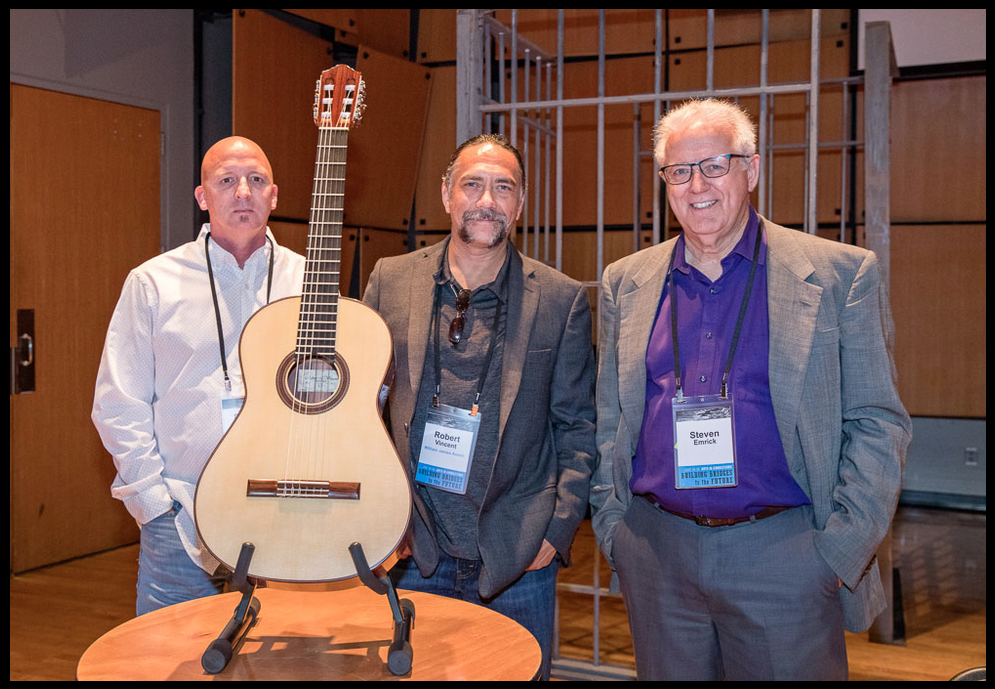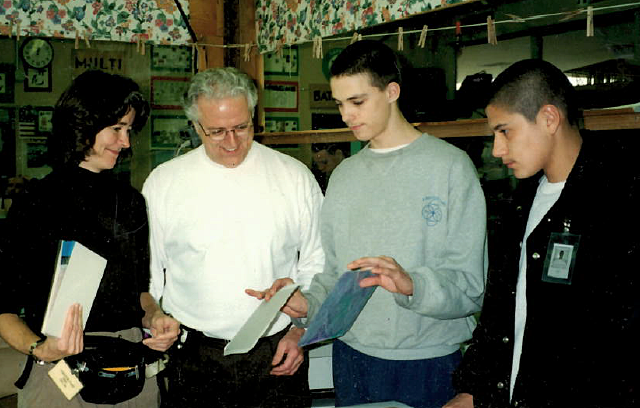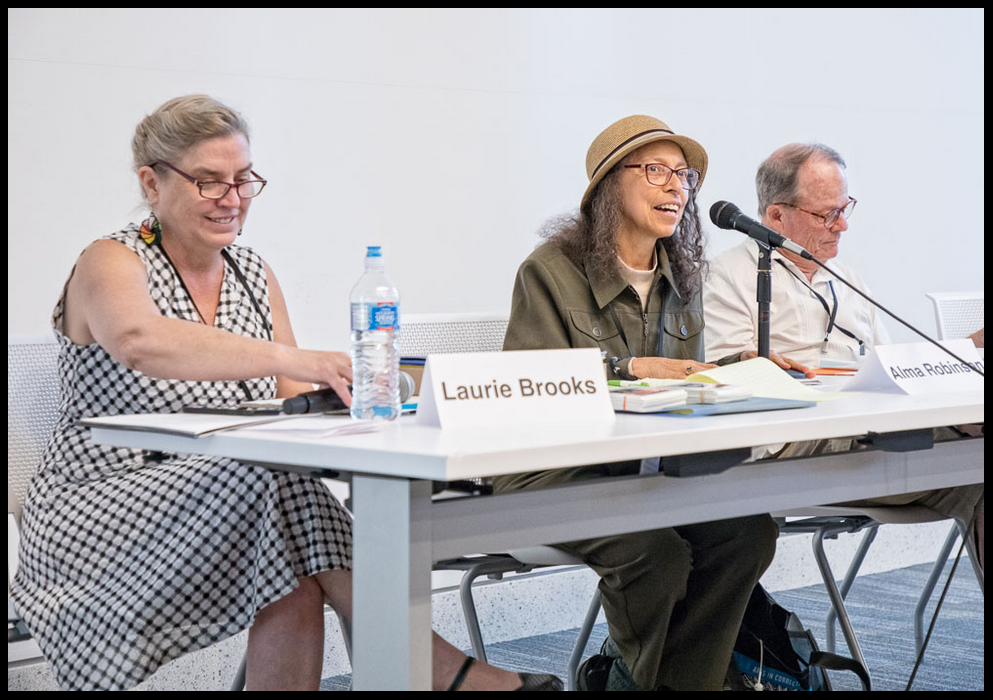Steve Emrick never sought to be a leader—but leadership found him. This is the fourth in a six-part series of posts based on an interview I conducted with Steve about his three decades running arts programs in California’s prison system. Section 3 ended with Steve explaining that right after receiving a “Heroes of Compassion” Award by the Dalai Lama, he was handed a pink slip.
Sarah: What did you do when you got the pink slip from the Department of Corrections?
Steve: To remain at San Quentin, I took a job as the assistant canteen manager. In my position I was mainly responsible for receiving large shipments of ramen soup packages and cereal and shaving cream. The shipments were offloaded in the warehouse. I received them and broke them into smaller deliveries to be taken to the canteen. I also supervised the canteen workers.
It was quite a step down in salary and stature. I went from running my own arts program to running a forklift. I’d grown up as a laborer in a farming area and I’d worked construction, so in some ways the transition wasn’t that difficult for me. But it was quite a blow to my ego. And the staff resented me because they viewed me as this guy who doesn’t know how to do all these things. Plus they were angry because I’d been given the job over one of their peers who wanted it. But eventually I was able to turn it around and get on good terms with the staff.
Sarah: How did you do that?
Steve: I just acknowledged, Hey, I’m here because I lost my position. I talked to the person who had been hoping to get the job and I said, I didn’t try to take your job. In the end we all got along well. I work hard and I have a fairly cheery demeanor. And the staff are really good at what they do. They have high school educations and I have two masters degrees, but they can run the till and balance the register faster than I can.
But it’s not the most fun work. You’re working at the windows where the inmates line up to buy stuff, and you have to tell some guy he doesn’t have enough money to buy something he wants, and now you have an upset customer who happens to be in for murdering someone. Sure, you have a little window between you and him, but on your work break you’re going to have to walk by this guy.
There’s a funny story from that time. To appreciate it you have to know that I try never to swear. So this inmate was at the window trying to get us to exchange something he had bought. I said, Look, you ran out of money and you know the prison policy—you can’t exchange goods. He kept arguing with me. Finally I said, Goddammit, I already told you, no! Then I said, And now you’ve made me swear! All the other guys in the line started saying, Look, man, come on, you’re making him swear, that’s not cool!
After that, the workers would say, How’s your day going, Steve? And if I was feeling stressed I’d say, I’m about ready to swear. They’d say, Oh boy, Steve’s having a bad day!
During that period of 2010–2012 when I was working in the canteen, I continued working to keep the arts program alive as best I could, including serving as a liaison between the prisoners and the prison staff. Laurie Brooks, who was working for no money, had to step up and take more responsibility for the functioning of the studio. An artist named Carol Newborg was also volunteering to do program management.
Sarah: What kinds of things were you doing as a liaison?
Steve: For example, there would be a conflict over the tool inventory. Not all the tools could be accounted for, which as you can imagine is a big deal in a prison. In situations like these, the studio would go into lockdown. I’d go in and meet with the artists and the inmates and figured out how to remedy it. Then I’d meet with the prison administration and said, Here’s what we’ve done, we’ve fixed it, please allow us to open back up. And they’d say, OK, but moving forward you need to do X or Y.
So I was mostly working in the background but when big things came up like that, I’d step in. That’s still the case now. Something will happen that locks down the art studio and I can negotiate to get it opened up. I try not to misuse my position. But I do mediate when there are conflicts with officers. And not just for the art program, but for all the volunteer programs.
Next: Everyone Everywhere Deserves to Make Art
-
August 2021
- Aug 31, 2021 The Heart Is the Major Target—Part 9: The Teacher Role Isn't My Essence Aug 31, 2021
-
June 2021
- Jun 13, 2021 The Heart Is the Major Target—Part 8: Machines Spilling Out Teachers Jun 13, 2021
-
April 2021
- Apr 14, 2021 The Heart Is the Major Target—Part 7: A Waterfall of Inspiration Apr 14, 2021
-
February 2021
- Feb 14, 2021 The Heart Is the Major Target—Part 6: Grab the Right Computer File Feb 14, 2021
-
December 2020
- Dec 26, 2020 The Heart Is the Major Target—Part 5: Yoga Is My Second Child Dec 26, 2020
-
November 2020
- Nov 5, 2020 The Heart Is the Major Target—Part 4: Wow, This Is Me Nov 5, 2020
-
October 2020
- Oct 4, 2020 The Heart Is the Major Target—Part 3: In Exile in My Own Country Oct 4, 2020
-
August 2020
- Aug 23, 2020 The Heart Is the Major Target—Part 2: Openness to the Unseen Aug 23, 2020
- Aug 2, 2020 The Heart Is the Major Target—Part 1: Let's Move Around; We'll Feel Better Aug 2, 2020
-
July 2020
- Jul 25, 2020 Educator Wellness Series Conclusion: Moving Forward with Wellness Jul 25, 2020
- Jul 6, 2020 Educator Wellness Practice #10: Inhabiting the Dignified Stance of "Adequate" Jul 6, 2020
-
June 2020
- Jun 17, 2020 Educator Wellness Practice #9: Jun 17, 2020
- Jun 3, 2020 Educator Wellness Practice #8: Reducing Stress Through Body Scanning Jun 3, 2020
-
May 2020
- May 21, 2020 Facebook Live Event: A Conversation About the Impact of Saying Goodbye to Students May 21, 2020
- May 13, 2020 Educator Wellness Practice #7: Setting Intention and Letting Go of Results May 13, 2020
- May 6, 2020 Educator Wellness Practice #6: Practicing Goodwill as Self-Care May 6, 2020
-
April 2020
- Apr 29, 2020 Educator Wellness Practice #5: Dealing with Constant Change Apr 29, 2020
- Apr 22, 2020 Educator Wellness Practice #4: Listening to Silence Apr 22, 2020
- Apr 21, 2020 Facebook Live Event: A Conversation About the Importance of Self-Care Apr 21, 2020
- Apr 15, 2020 Educator Wellness Practice #3: Apr 15, 2020
- Apr 8, 2020 Educator Wellness Practice #2: Engaging Wisely with News and Media Apr 8, 2020
- Apr 1, 2020 Educator Wellness Practice #1: Breathe ... Keep Breathing Apr 1, 2020
-
March 2020
- Mar 25, 2020 Educator Wellness Series for Collaborative Classroom Mar 25, 2020
-
May 2019
- May 19, 2019 Managing to Build Bridges - Part 8: Do We Want to Be Right in a Dictionary Sense? May 19, 2019
-
April 2019
- Apr 27, 2019 Managing to Build Bridges - Part 7: You Just Need to Find a Good Husband Apr 27, 2019
- Apr 6, 2019 Managing to Build Bridges - Part 6: Human Remains and Cultural Artifacts Apr 6, 2019
-
March 2019
- Mar 17, 2019 Managing to Build Bridges - Part 5: Poetry Has No Rules Mar 17, 2019
- Mar 3, 2019 Managing to Build Bridges - Part 4: Dessert Goes to a Different Stomach Mar 3, 2019
-
January 2019
- Jan 13, 2019 Managing to Build Bridges - Part 3: I Felt Pretty Stupid Jan 13, 2019
-
December 2018
- Dec 9, 2018 Managing to Build Bridges - Part 2: Such a Bad Kid Dec 9, 2018
-
November 2018
- Nov 23, 2018 Managing to Build Bridges - Part 1: The Pressure to Be a Certain Type of Girl Nov 23, 2018
-
October 2018
- Oct 23, 2018 Leadership Without Ego - Part 6: Mayberry with an Edge Oct 23, 2018
- Oct 1, 2018 Leadership Without Ego - Part 5: Everyone Everywhere Deserves to Make Art Oct 1, 2018
-
September 2018
- Sep 10, 2018 Leadership Without Ego - Part 4: I'm About Ready to Swear Sep 10, 2018
-
August 2018
- Aug 19, 2018 Leadership Without Ego - Part 3: The Dalai Lama Breaks All the Rules Aug 19, 2018
-
July 2018
- Jul 29, 2018 Leadership Without Ego - Part 2: The Kids Melted Under That Praise Jul 29, 2018
- Jul 10, 2018 Leadership Without Ego - Part 1: The Workshop Was Neutral Territory Jul 10, 2018
-
May 2018
- May 26, 2018 The Alchemy of Service - Part 5: Watch Out, Someone's Behind You May 26, 2018
- May 6, 2018 The Alchemy of Service - Part 4: Fireworks and Tears May 6, 2018
- May 5, 2018 The Alchemy of Service - Part 3: Joann Wong! You Are Chinese! May 5, 2018
-
April 2018
- Apr 6, 2018 The Alchemy of Service - Part 2: Mom, It's Only a Nickel Apr 6, 2018
-
March 2018
- Mar 19, 2018 The Alchemy of Service - Part 1: Mouse Soup Mar 19, 2018
-
February 2018
- Feb 18, 2018 Back to the Garden - Part 4: Mountain Lion Footprints on the Deck Feb 18, 2018
- Feb 3, 2018 Back to the Garden - Part 3: "You're a Good Egg—Happy Easter" Feb 3, 2018
-
January 2018
- Jan 15, 2018 Back to the Garden - Part 2: "A Pretty Big Failure" Jan 15, 2018
- Jan 1, 2018 Back to the Garden - Part 1: "Aesthetic Shock" Jan 1, 2018
-
August 2017
- Aug 15, 2017 Goodbye Self-esteem, Hello Self-compassion – Part 3: Real Love Aug 15, 2017
-
July 2017
- Jul 31, 2017 Goodbye Self-esteem, Hello Self-compassion – Part 2: Mirror, Mirror Jul 31, 2017
- Jul 17, 2017 Goodbye Self-esteem, Hello Self-compassion – Part 1: Bashing Vasco Jul 17, 2017
-
May 2017
- May 28, 2017 This Thing I Found: Teens Teach Us How to See Freshly May 28, 2017
-
March 2017
- Mar 20, 2017 Dream On - Part 6: Dream Analysis Example Mar 20, 2017
- Mar 7, 2017 Dream On - Part 5: A Dream Analysis Technique (cont.) Mar 7, 2017
-
February 2017
- Feb 20, 2017 Dream On - Part 4: A Dream Analysis Technique Feb 20, 2017
-
January 2017
- Jan 22, 2017 Dream On - Part 3: Recording Dreams Jan 22, 2017
- Jan 15, 2017 Dream On - Part 2: Dream Recall Jan 15, 2017
-
December 2016
- Dec 30, 2016 Dream On – Part 1 Dec 30, 2016
- Dec 12, 2016 Enjoying the Ride of Serendipity Dec 12, 2016
- Dec 6, 2016 Agnes Martin: A Singular Career Dec 6, 2016












